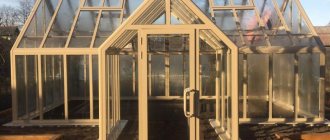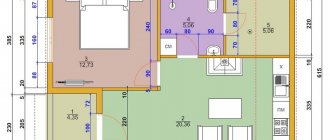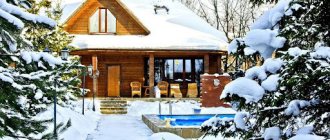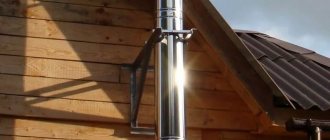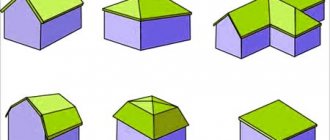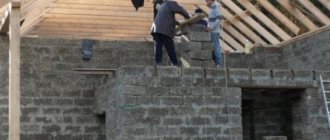To build a house from scratch, in order to competently carry out all construction work, you must have a clear plan before starting.
Construction companies help with this, but you can figure out the process yourself: to do this, it is recommended to familiarize yourself with the main stages of constructing a home.
Why is it important to know the procedure?
The image of a house appears in the minds of the owners of the site, but often few people know how to apply this image in practice. I would like to immediately have a finished house, move into it and live there, but in reality construction drags on for years, decades, especially if you don’t know the stages of housing construction.
Why is it so important to know all the steps to build a house on the site:
- This will help prevent mistakes during construction. It doesn’t matter whether the house will be built on its own or a contractor will be invited, the owner must be aware of the work taking place. There are also construction companies that sell a lot of services to the client, but the client himself does not know whether their proposals are correct. Therefore, before you take on the construction of a new building, it is better to find out what stages and in what sequence are performed for this.
- This will help save money. Overspending on construction materials is one of the main problems when allocating a budget. If you don’t calculate in advance how much the house will cost, and don’t think through the amount of materials, you’ll have to constantly spend more. Construction is already associated with regular expenses, but if the owner has an estimate, it will be easier to save money.
- This will help avoid problems with the law. It is known that all residential buildings must be built in accordance with SNiP. This set of rules allows you to avoid emergency situations during construction and during operation. When registering a house, if it is built according to all standards, there will be no questions from the legislative bodies.
Knowing the stages of constructing a residential building provides many advantages. The owner can easily realize all his plans for future housing if he is informed during the construction process.
Process step by step
There are the following stages of building a house:
- G
geological and geodetic checks; - preparation of an architectural project;
- preparation of construction project and estimate;
- laying and installation of communications on the site;
- installation of a foundation for a house;
- construction of walls, partitions and ceilings;
- roofing work;
- installation of doors and windows;
- insulation and finishing of facades;
- installation of utilities inside the house;
- Finishing work.
Any construction begins with a search for a site, but if it is already owned, it is important to check all documents for their compliance with the law. To do this, contact a notary and the BTI.
When the documentation is ready, geological work is carried out on the site:
- take soil samples;
- determine the level of groundwater and the level of soil freezing in the region.
Geological work is necessary in order to choose what type of foundation is suitable for building a house.
Next, they develop architectural and construction projects - you can do this yourself or contact specialized companies. After this, estimate documentation must be prepared - this will give an idea of the possible costs.
The next stage will be the installation and installation of communications on the site. During construction, power tools are often used, so electricity must be supplied, as well as water. If there is a gas pipe nearby, then gas must also be piped to the site.
Next, choose the type of foundation and build it . Then they are engaged in arranging walls, floors, ceilings, and partitions. They make a roof, install windows and doors, and insulate the facades if necessary. At the final stages, communications are brought into the house and interior decoration is carried out.
Stage five. Buying materials to build a private house with your own hands
According to the majority of people who have built a dacha or a house for themselves, the biggest problems can be encountered when choosing materials according to the principle - whatever is cheaper, we take it. Not only do cheap materials, for example finishing materials, not look very presentable, which spoils the overall appearance of the house, but their durability is also in question. Therefore, in order not to find yourself with a problem alone, choose materials guided by the following rules:
- Never forget that all building materials have guarantees and certificates from manufacturers. Demand from suppliers so that later, if any controversial issues arise, you can prove that you are right;
- Buy materials in advance, since during the high season, that is, during the warm season, the market often experiences a shortage of the most popular building materials, the supply of which does not keep up with the high demand;
- Never, remember, never use good old slate for roofing work. His time has already passed, believe me. And those who still live in the past and believe that slate can be laid on the roof of a residential building are harming themselves. Here are the best materials, in our opinion, for the roof of a residential building.
Differences for permanent and country buildings
In general, the stages of building a country house and a house suitable for permanent residence will be identical.
The only difference will be the following:
- for a country house there is no need to connect all communications: for example, you can do without gas;
- the design of a country house will be simpler;
- geodetic and geological work will be carried out in a simplified version.
Since country houses are intended for seasonal living, the stage of insulating the facades can be omitted. In addition, all construction work will be faster and easier, since there is no scale.
Rules for construction on land plots
As mentioned above, there are construction norms and rules that must be followed.
They touch:
- purpose of land (land can be intended for individual construction, or maybe only for garden houses);
- size and area of the site;
- sanitary standards;
- fire safety;
- distances between buildings.
It is also important to take into account the norms for the indentation of objects from the border:
- with neighbors;
- tree planting standards;
- construction of additional facilities, such as a bathhouse and a garage.
The rules for installing a fence on a plot of land are also important.
Legislative regulation
To start building a house on a plot of land, it is recommended to look at the following documents :
SNiP 30-02-97.
This code regulates the planning and development of the territories of gardening associations of citizens, buildings and structures. The regulation states how to determine the location of objects on a site relative to its boundaries.- SNiP 2.07.01-89. It tells about the planning and development of urban and rural settlements. The act defines the rules for laying pipelines and water supply between different sections.
- SNiP 2.04.01-85. He will tell you about the standards for laying internal water supply and sewerage systems.
- SNiP 2.04.08-87. Will tell you about gas supply standards at the site.
All these sets of rules will help you understand housing construction legislation at its initial stage.
Learn more about the standards and rules for building a house on a self-storage basis here.
SIP technology
Another frame-panel technology is SIP technology. It is often called Canadian, but it has nothing to do with Canada. The first structural thermally insulated SIP panels were produced in the USA, and therefore it would be more correct to call this method of house construction American.
Section of a house made from SIP panels.
A SIP panel is a combination of OSB boards and expanded polystyrene (PSB-S25) glued together. And although none of the materials has load-bearing capacity, in duet they form a durable monolithic sandwich structure (OSB/PSB/OSB). This technology has many advantages and disadvantages. The building retains heat well and warms up quickly. This is a good option for non-year-round homes and areas where there is no centralized gas heating. The use of vapor-tight insulation allows you to get rid of condensation at the dew point inside the wall. In addition, since walls made from SIP panels are perfectly flat, drywall is installed on them without metal profiles, which speeds up work and helps reduce financial costs.
And now about the cons. The main one is expanded polystyrene, about the environmental friendliness and fire safety of which you can find diametrically opposed opinions. Although special additives make the material self-extinguishing (as indicated by the letter “C” in the PSB-S marking), domestic developers are still very doubtful about SIP technology, not wanting to live in a “foam house.”
How to choose the right project for a country cottage?
In order not to get lost in the wide variety of types of houses, it is recommended to understand what they are like :
- garden or country houses;
- cottages;
- country houses for permanent residence.
Garden or country houses are intended for seasonal living. From the point of view of insulation, the requirements here will be lower, and the project will also be simpler. This reduces the cost of building such housing.
Cottages are spacious buildings for temporary or permanent residence. Their cost is higher, since the requirements are also higher. Houses in a village or cottage community are intended for permanent residence, so they will be supplied with all communications, insulation, they can be two-story or attic.
To choose the right project, it is important to pay attention to the following criteria :
- this is a characteristic of the soil on the site;
- choosing the type of foundation depending on the terrain;
- the size of the plot and the area of the house itself.
You can contact an architectural bureau, but first draw out your wishes on a piece of paper yourself.
Read more about the types of houses here.
If the house has four rooms
Housing with four rooms is easier to zone, and it is suitable for a large family. The right side of the building is reserved for relaxation, the left for activity, or vice versa. In such a house they plan:
- hallway with vestibule;
- 3 bedrooms;
- corridor between separate rooms;
- living room;
- kitchen;
- bathroom
If the space allows, arrange a laundry room, a veranda with an exit from the bedroom, and a second porch with an exit from the kitchen.
In the process of designing interior spaces, the location of sources of natural light should be taken into account. It is advisable to design rooms in certain proportions, so that they are not too elongated along the length, and their depth does not exceed 6 meters.
An example of the layout of a house consisting of four living rooms Source ar.decorexpro.com
Notification of the start of construction and permission
One of the documents about the start of construction is a notification that is submitted to the official authorities. To submit it, you need to fill out a special form.
The notification contains information about:
- owner, data about the plot (for this you need an extract from the Unified State Register), data about the future house;
- site plan with outlines of the house.
In this case, the site must undergo a land surveying procedure so that its boundaries are shown on the plan. Permission to build a house is no longer required.
Until 2022, the Town Planning Code of the Russian Federation assumed the existence of this document, but it was later abolished. At this time, only notification is required.
Even more information in this article.
Video description
See the video for the nuances of the 10x10 house layout:
Planning the location of windows
Living rooms are located on the sunny side. The illumination should be sufficient to preserve vision, but not lead to fading of furniture and wallpaper. If the layout of the rooms in the house involves the construction of a glass wall, it is necessary to equip it with protective blinds or blackout curtains.
You can build a standard house - in small bedrooms there is one window, in living rooms there are always two. If the eating area is shared with the kitchen, then it is better to make three window openings here.
You can give free rein to your imagination and plan special windows: long, round, tall windows with an arch at the top.
A large number of windows provide plenty of light and fresh air. There is no need to worry that they will cause cold in the house. Modern multi-chamber windows have excellent thermal protection properties.
Large corner window in the bedroom Source houzz.in
List of documents
To formalize the start of construction of a house in accordance with all laws, it is important to prepare the necessary documents :
resolution on the provision of a land plot for individual housing construction;- purchase and sale agreement (if available);
- general plan;
- site passport;
- act on establishing the land boundaries of the site;
- private residential building project.
The project includes information such as:
- situational plan;
- communications wiring diagram;
- floor plans;
- facades;
- cuts;
- topographic survey of the adjacent part of the street, as well as a general plan of the site;
- basement plan;
- foundation;
- roofs;
- roof truss system.
Read more about the documents here.
Preparing land for development
To prepare the land on the site for building your own home, you need to complete an action plan :
- Check the communications system laid on the site.
- Clean the area: remove old trees, stumps, branches and debris.
- Carry out excavation work. This includes determining the groundwater level, soil composition and type. Analysis is necessary to understand which foundation will be preferable.
- Install utility rooms on the site that will be intended for storing tools or housing workers.
You can do all this on your own, but if you contact a specialized company, they will perform this list of services.
Read more at the link.
Video description
To see what a house should be like, watch the video:
Balcony in a private house
Some owners of private houses with balconies hardly use these extensions. According to people, it is easier to go out into the yard or onto the terrace. That is why the need for a balcony must be thought out in advance.
If you want to make one, then you should not build a small balcony similar to those that are equipped in apartment buildings. A large balcony is turned into a work of art using forged or other equally beautiful railings.
There should be enough space on the balcony for a comfortable rest - so that you can put several sun loungers or a rocking chair, a table with chairs for tea drinking.
Large balcony in a private house, equipped with everything necessary for a comfortable stay Source pinterest.com
The balcony fence must be at least one meter high to ensure safety. If there is no canopy, snow may drift onto the balcony in winter. If the floor does not have a slope, then after rain water will stagnate there.
Organization of the site
Preparing a construction site is one of the initial stages. This is a set of measures for clearing, cleaning, and dismantling structures on the territory. This includes work such as :
fencing the territory;- dismantling and demolition of all existing buildings;
- rerouting of communications;
- laying temporary communications;
- protection of the site from surface waters;
- organization of temporary access roads.
If the site was already owned and gas was supplied to it, but the pipe was located low, this could cause difficulties when operating construction equipment, for example, a crane. To do this, it is necessary to reroute the gas pipeline and raise the pipe higher.
Full article about the organization here.
Creation of temporary fences
Temporary fences are fence structures that are installed around the perimeter of the site. Their main task is to determine the boundaries of the territory and create an obstacle to free movement around the site. A temporary fence is made without a foundation.
Such fencing is necessary on the construction site. You can build it with your own hands in a short period of time. Most often it is made from chain-link mesh, corrugated sheets or lumber.
There is even more information about temporary fencing here.
Canadian technology
The peculiarity of the Canadian version is that all blanks for the cottage (they are produced in a factory) are delivered to the site in the form of separate parts of a construction kit. The basis of the building is a frame consisting of beams, beams and trusses. For their manufacture, either high-quality planed softwood lumber is used, dried in a chamber to 18% humidity, or laminated veneer lumber (this is a more expensive option). The outside of the house is most often sheathed with oriented strand moisture-resistant OSB (Oriented Strand Board) boards 12 mm thick. Some companies use 12 mm cement particle boards for this purpose, or OSB boards on the outside, and soft wood boards 100 mm thick on the inside. Thermal protection of a building is created, as a rule, using basalt wool (total layer thickness - 150–200 mm). On the inside of the frame, the thermal insulation is covered with a vapor barrier film, and on the outside - with a wind and waterproof film. The “pie” of the wall from the inside is completed with sheets of plasterboard, which serves as the basis for the finishing, while on the outside there are various finishing materials: block house, lining, siding, plaster, etc.
The advantages of the Canadian option include high heat and energy-saving characteristics of the building, the ability to build houses with geometrically complex configurations, and the fact that construction can be carried out at any time of the year without loss of quality. The disadvantages are the problem of ventilation, which is inherent in all types of frame houses. The optimal solution (this is what they do abroad) is to install a climate control system. However, you can limit yourself to forced ventilation, at least in the kitchen and bathrooms, and provide air exchange in living areas with normal ventilation. Otherwise, it will be difficult to breathe in the house, moisture will begin to accumulate in the insulation, due to which it may lose its heat-protective properties, and the frame may rot.
The cost of frame-panel houses ranges from 15,000 to 27,000 rubles/m²
When weighing the pros and cons of the Canadian option, there is something else worth thinking about. In Canada, the wide popularity of this technology is explained by the very strict rules for accepting a house by the national government inspectorate, which checks the object twice: at the stage of assembling all panel elements, with the exception of the internal cladding, and at the stage of handing over the cottage. In Russia there is no such state acceptance, and since the human factor plays a decisive role in this technology, the quality of the house directly depends on the work experience and qualifications of the specialists of the company leading the construction. Often, under the brand name of a Canadian house, semi-handicraft technologies are sold, which involve the production of frame posts directly on the construction site, and from undried wood. As a result, the building may become deformed due to natural shrinkage of the racks. Savings for the developer on the thickness of the insulation or its quality, on the quality of steam and wind protection films, etc. will also be costly.
Storage layout
There are a number of rules and nuances when planning a construction site:
- To begin with, they determine the nature of the soil of the earth. If the groundwater level is high, then drainage work must be carried out. If the aquifer is deep, the location for drilling the well is determined.
- Mutual arrangement of buildings. Often, when planning, they include such capital construction projects as a residential building, outbuildings, a recreation area, a garage, a sauna, a children's playground, and a garden area. All this must be arranged organically and maintaining the permissible distance between them.
The location for the house is chosen depending on the terrain. If there is a hill on an empty plot, then it is better to place the house there. There are central, deep and front landings of the house. Outbuildings are located away from the house. The garage is located as close to the exit as possible.
Planning rules for different plot sizes are in the section at the link.
Stage four. Landscape design
Even twenty years ago there were disputes about landscape design, but today it is reliably known that its design is extremely necessary and important. And that's why:
Neighborhood friendship
- Professional landscape design allows you to ensure proper insolation, which in turn makes it possible to create comfortable conditions in all living areas of the house; landscape design is not only bushes and trees with stone gardens, it is also the competent laying of all utilities;
- When designing a landscape, you can take into account in advance such aspects as drainage, the location of retaining structures, transport areas and recreation areas;
- If there are already green spaces on the site, then make sure in advance that they are protected by fences and film during construction work.
We would also like to add that any landscape design project must be coordinated with the architectural authorities in whose area of authority your site is located.
Main mistakes
At the pre-construction stage, one of the main mistakes is incomplete paperwork. If this is not done, then in the future, when the house is already built, you may receive a fine for non-compliance with standards. In addition, if land surveying is not carried out, you can sue your neighbors for a long time over 20 cm of fence.
At the start of construction, the following errors may occur :
discrepancy between the bearing capacity of the soil and the weight of the house;- insufficiently strong foundation;
- insufficient protection of the base from moisture and frost;
- incorrectly prepared architectural design;
- lack of estimate;
- incomplete clearing of the site for construction;
- improper placement of buildings on the land plot.
To avoid problems in the future, it is recommended to immediately work out an action plan, make a design of the house and land, and also formalize everything in accordance with the law.
Frame technologies
Anyone who is at least a little interested in the issues of private housing construction knows that one of the fastest technologies is frame. Even ten years ago, our compatriots had an opinion about “frame houses” as unreliable, flimsy houses, suitable only for a summer cottage. Today, frame technologies are gaining momentum not only in the USA, Canada and Europe, where they are rather traditional, but also in Russia. An important factor for domestic developers is that a frame house can be made quite warm, bringing it closer to modern building energy efficiency requirements.
The most famous are three options for a frame house: frame-frame (also called Canadian), panel-frame (German) and house made of SIP panels (American)
